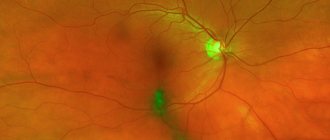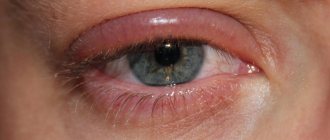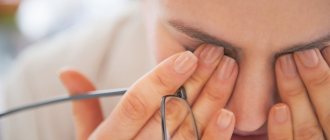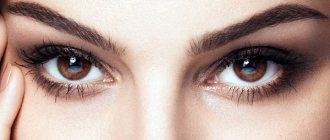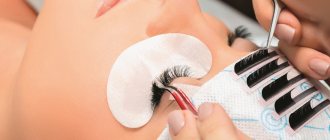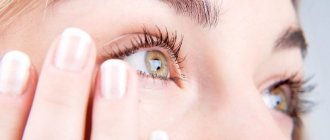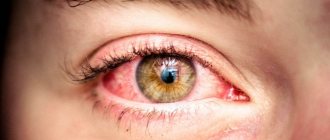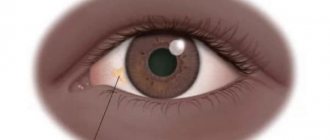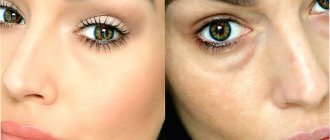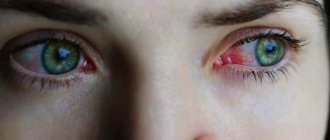For many, the appearance of a red spot on the eye is not a dangerous symptom. People believe that a capillary simply burst due to excessive fatigue or injury, and wait for the trouble to go away on its own. Indeed, in some cases this happens, but this does not mean that the symptom goes away without a trace or cannot be a harbinger of serious problems. Why does a red spot appear on the eye and how is it treated?
Share
Tweet
Share
Cool
Send
What is a red spot on the white of the eye?
A red spot on the white of the eye is an accumulation of blood on the sclera, which appears as a result of rupture of the blood vessels in the eye. Hemorrhage leads to the appearance of spots of different sizes, localization and nature, and this depends, firstly, on the cause of the disease, and secondly, on which vessel was damaged.
REFERENCE! By nature, a red spot on the eye is a bruise.
The appearance of a red mark on the white body of the eye is always obvious to others and the person himself. Hemorrhage is never an independent symptom (with the exception of injury) and is always a consequence of the development of more dangerous pathologies.
To determine what exactly is causing the eye hemorrhage, you need to be examined by an ophthalmologist, but sometimes consultation with other specialists is required.
Red spots under the eyes (around the eyes)
Our skin is one of the first to react to any negative changes in the body. The more sensitive the skin, the faster and brighter the signs of any disease appear on it. The thinnest layer of skin is located in the area around the eyes. As a rule, the skin in this area is uniform in color, one tone lighter or darker than the base color of the facial skin. But sometimes red spots appear under or around the eyes, which can signal a number of diseases of the visual organs or the entire body as a whole.
Causes of red spots under the eyes
Various factors can cause the appearance of red spots around the eyes, including:
- Stress, lack of sleep and nervous tension. When the daily routine is normalized and the emotional state is restored, the redness disappears
- Dermatological problems. For example, with eczema and dermatitis, the skin around the eyes not only turns red, but also flakes and may also become crusty.
- Kidney diseases - stones, kidney failure and other pathologies make themselves felt by the appearance of bags, swelling, as well as redness or darkening under the eyes
- Inflammatory processes - abscesses and phlegmon (purulent inflammation). In such cases, redness is accompanied by increased body temperature.
- An allergic reaction in which in addition to redness there is also itching
- Vitamin deficiency and unhealthy lifestyle: lack of exercise, lack of air, poor diet and bad habits often contribute to the deterioration of skin condition
- Congenital skin abnormalities.
Do not forget that only a specialized specialist can establish the true cause of the disease and help get rid of unpleasant symptoms.
Causes of the symptom
There is always some reason behind the violation of the integrity of the vessel. Doctors combine them into several large groups:
- infectious (conjunctivitis, blepharitis, keratitis, etc.) and viral eye diseases;
- injury;
- diseases of the cardiovascular system (hypertension, stroke);
- damage to the endocrine system (diabetes mellitus);
- excessive stress on the eyes and xerophthalmia - dry eye syndrome - as a consequence;
- intense sports activities;
- increased intraocular pressure;
- a sharp change in pressure (typical of pilots, people swimming at great depths, climbers);
- insufficient hygiene;
- congenital retinal abnormalities;
- vascular diseases;
- allergic;
- some autoimmune diseases.
Many women experience hemorrhage during childbirth, and this is considered normal.
In an adult
The reasons for the appearance of a red spot on the eye in adults and children differ. In adults, the prerequisites may be many more diseases, but the fragile blood vessels of a child's eye are more fragile.
Causes of eye hemorrhage in adults:
- Xerophthalmia, or dry eye syndrome. This syndrome may be associated with insufficient production of tear fluid, which develops as a result of congenital or acquired abnormalities of the lacrimal glands. Even more often, xerophthalmia is associated with excessive fatigue and strain on the eyes, for example, when working at a computer, reading or watching TV in the dark: a person has to strain his eyes, blink less often, so that the eye dries out. With a regular lack of hydration, a person may notice a red spot on the sclera.
- Mechanical and chemical injuries. An accidental blow or contact with an aggressive substance in the eye can lead to hemorrhage. A characteristic feature in this case is an extensive stain even with minor damage.
- Diseases of the endocrine system. Lack or deficiency of hormones leads to changes in blood composition, and this, in turn, can affect the strength of blood vessels. The likelihood of hemorrhage is especially high when hormonal changes are combined with hypertension.
- Changes in pressure associated with air travel, diving to great depths, and excessive physical exertion. The more often this happens, the higher the risk of hemorrhage.
- Excessive consumption of alcoholic beverages, especially if the person hardly drinks. Alcohol first causes blood vessels to dilate and then constrict. The blood vessels of the eye may not withstand such stress and burst.
- Lack of personal hygiene. This includes the use of low-quality cosmetics, inappropriate cleansers, sleeping with cosmetics on the eyes, and improper use of contact lenses.
- Allergy. Typically, allergic reactions are limited to swelling, tearing and redness of the eyes, but with severe allergies, hemorrhage is possible. This can happen while traveling to an exotic country through contact with unknown plants or after an insect bite.
- Infectious and viral eye lesions (conjunctivitis, blepharitis, iridocyclitis and others) are the most common cause of hemorrhage in the eye.
Causes
If red spots appear on the eyes, this may be due to various external and internal factors. The stain itself is blood that has escaped from the capillary. This can happen for many reasons:
- A common cause of the formation of red spots on the eyeball in adults is overwork. Prolonged hard work on a computer or working with small parts causes blood vessels to dilate, and some of them may burst.
- Mechanical damage to the organ of vision. Rubbing the eyes with your hands or a direct blow causes capillaries to rupture and small hematomas are formed. Children often suffer unintentional injuries during play.
- In a newborn, ruptured capillaries cause prolonged, strained crying. It leads to an increase in intraocular pressure, as a result of which the child’s thin vascular wall bursts.
- The appearance of red dots in a child's eyes is often caused by prolonged visual strain - watching TV, playing on the computer, reading in poor lighting conditions.
- Red spots in a child's eyes, combined with a fever and runny nose, are a symptom of a viral infection. Especially often, fragility of blood vessels in a baby is caused by adenovirus and measles.
- With increased fragility of capillaries, their rupture can be caused even by ordinary sneezing. When you sneeze, the pressure in the vessels of the nose and eyeball increases sharply.
- Increased pressure in the brain vessels causes cracking of capillaries and the formation of pinpoint bruises. This condition is observed in arterial hypertension and atherosclerosis.
- Redness of the whites of the eyes occurs when lifting heavy weights. This is also associated with increased intravascular pressure.
- Red eyes are observed in persons suffering from alcoholism. Alcohol causes persistent dilation of small blood vessels, which no longer return to their normal state.
- Capillary fragility is observed in some endocrine diseases - diabetes, pathology of the adrenal glands, thyroid gland.
- Redness of the sclera is observed in dry eye syndrome. This disease is characterized by increased dryness of the cornea and excessive secretion of tear fluid.
- Red spots on the conjunctiva and sclera appear against the background of the development of inflammatory processes. They are caused by edema and vasodilation.
- In women during childbirth, the eye capillaries burst from severe overexertion. This usually happens at the height of contractions.
- Temporary redness of the eyes can be caused by using incorrectly selected glasses and lenses.
Almost every condition in which red spots form requires consultation with an ophthalmologist. They do not pose a significant danger, but treatment is required.
About hemorrhage in the eyes, watch the episode of the program “About the Most Important Thing”:
Diagnostics
If areas of hemorrhage appear on the white of the eye, you should visit an ophthalmologist. To make a diagnosis, he will need to carry out a series of diagnostic measures, after which treatment will be prescribed. The child should be taken to the pediatrician immediately.
IMPORTANT! Immediate treatment is required when accompanying symptoms appear: itching, burning, pain, lacrimation, headache, impaired visual acuity, blurred images, and the appearance of blind spots.
In most cases, it is enough for the ophthalmologist to:
- check visual acuity;
- examine the fundus;
- measure intraocular pressure.
Common Causes of Yellow Spots in the Eye
Yellowing of the entire sclera of the eye is a symptom of a condition called jaundice. Jaundice occurs when bilirubin metabolism is disrupted. For various reasons, bilirubin is not excreted by the liver, and it begins to accumulate in the skin and mucous membrane of the eye, causing a change in eye color.
Diseases that can lead to jaundice:
- Alcohol abuse causes liver cirrhosis
- Hepatitis develops due to a viral infection of the liver
- Liver cancer
- Fatty liver develops in obese people
- Gallstones
- Anemia
Any common reasons that led to the appearance of yellow eyes require a thorough examination of the body and medical care.
Eye diseases as a cause of yellow spots
Yellow spots in the eye occur due to diseases that usually do not cause irreversible changes and do not lead to vision loss.
● Pinguecula
. This is a thickening of the mucous membrane that is yellow in color. Yellow spots appear on the outside, symmetrically, in the corners of the eye. Typically occurs in older people. Pinguecula develops due to aging of the mucous membrane.
● Pterygium
. Thickening or growth of the mucous membrane in the inner corner. It looks like a yellow triangular spot. In some cases, it turns red and bright pink. It is the result of aggressive exposure to physical environmental factors (hot and dry climate, intense ultraviolet radiation, strong wind).
● Dermoid cyst of the conjunctiva
is a benign neoplasm. This is a congenital defect characterized by a dense capsule containing fatty contents. Tends to grow.
● Conjunctival cyst
may have a yellowish tint and look like a spot on the eye.
● Nevus
. A yellow-brown spot can be localized in any part of the sclera, both in the inner corner of the eye and in the outer one.
● Horner-Trantas spots
. Small yellow spots appear around the cornea and on the white of the eye; they look like small round grains. The cause is eye allergies.
Treatment
Treatment is prescribed based on the underlying cause of hemorrhage in the eye. In the absence of any damage, it is only recommended to reduce the load, review your lifestyle and diet. The symptom is eliminated by applying a cold compress, taking vitamins and special eye drops.
In other cases, complex therapy is required to help eliminate the underlying disease.
Medication
To eliminate the symptom itself, drops of Tsipromed, Tobrex, Levomycetin, Albucid, Normax are prescribed. They need to be instilled into the eyes 3-4 times a day, 1 drop. Even if only one eye is affected, both should be instilled.
For dry eye syndrome, Visin, Inoxa, Slezin, Visomitin are prescribed.
If the problem lies in increased intraocular pressure, medications are prescribed to normalize it. This can be achieved using three groups of drugs:
- to improve blood circulation (Cosopt, Fotil);
- to reduce the production of aqueous humor (Timolol, Betoptik);
- to improve the removal of ocular fluid (Epiphrine, Travatan, Xalatan, Pilocarpine).
For allergies, antihistamines are prescribed, as well as special drops, gels and ointments for the eyes (vasoconstrictors, antihistamines, anti-inflammatory, corticosteroids). Be sure to avoid exposure to allergens.
Hemorrhage that occurs as a result of injury does not require drug treatment. It is recommended to apply cold compresses regularly.
Infectious lesions are eliminated using antibacterial drops or ointments. Levomycetin, Tobrex, Albucid are the most effective.
In case of excessive strain on the eyes, dry eye syndrome or hemorrhages of unknown nature, combined drugs are prescribed: Normoglaucon, Cosopt, Fotil.
REFERENCE! Regardless of the reason for the appearance of red spots in the eyes, it is recommended to remain calm: get more sleep, do not use cosmetics, and stop working at the computer and watching TV for a while.
Emergency resuscitation with surgical methods is required for stroke, brain tumors and serious eye damage (for example, retinal rupture). Surgical measures are also required for hemorrhage in the orbit.
Homeopathic
Homeopathy is a type of alternative medicine that uses highly diluted remedies, usually natural ones, for treatment. A classic example of a homeopathic treatment method is the use of soda solution for heartburn.
In ophthalmology, homeopathic treatment is also often used, especially for hemorrhages.
- Arnica is used for eye injuries and conjunctivitis.
- Akonitum is prescribed for infectious and inflammatory diseases, as well as for hemorrhages after acute respiratory viral infections.
- Fluoricum acidum is indicated for dry eyes and photophobia accompanying the formation of red spots.
- Hepar sulfur is effective for purulent inflammation of the eyes with hemorrhage.
- Rue is used for heavy eye strain.
Among the homeopathic drops, Similasan, Boiron, Oculoheel are well known. These drops effectively eliminate irritation and dryness, have a preventive effect on many diseases, relieve tension and moisturize well.
Traditional methods
The attitude towards traditional methods is ambiguous, since some doctors believe that this treatment method can provoke the addition or spread of infection. In some cases, unconventional remedies are beneficial, but they can only be used after consulting a doctor.
Prevention
To prevent the appearance of red spots on the eye, you should follow simple rules.
First, it is necessary to reduce eye strain. When working at a computer, you need to take regular breaks, do eye exercises, and take into account all the rules for arranging your workplace (lighting, screen brightness, distance from the eyes to the monitor). You cannot read or watch TV in poor lighting.
Secondly, you need to adhere to proper nutrition and get enough vitamins from food. If you have vitamin deficiency and deficiency of nutrients, you can take multivitamin complexes that contain vitamins A, E, C. The diet must include fresh fruits and vegetables.
Thirdly, it is necessary to monitor basic health indicators: blood pressure, blood sugar levels, heart rate.
Prevention of ophthalmological diseases is inextricably linked with maintaining personal hygiene, using high-quality cleansers and cosmetics, and competent handling of contact lenses. In sunny weather and strong winds, it is recommended to wear sunglasses.
Expert opinion
Slonimsky Mikhail Germanovich
Ophthalmologist of the highest qualification category. Has extensive experience in diagnosing and treating eye diseases in adults and children. More than 20 years of experience.
To prevent allergies, you need to regularly ventilate the room and do wet cleaning, and also carefully monitor the reaction when eating new foods or using new cosmetics. During the allergy season (spring-summer period), it is advisable to contact an allergist and ask to prescribe an antihistamine for prevention.
It is also recommended to follow safety precautions to avoid injury.
